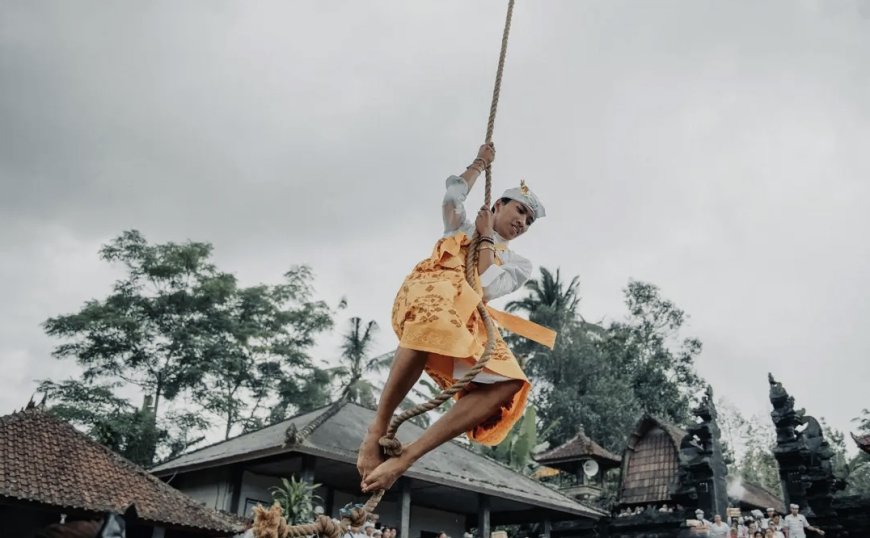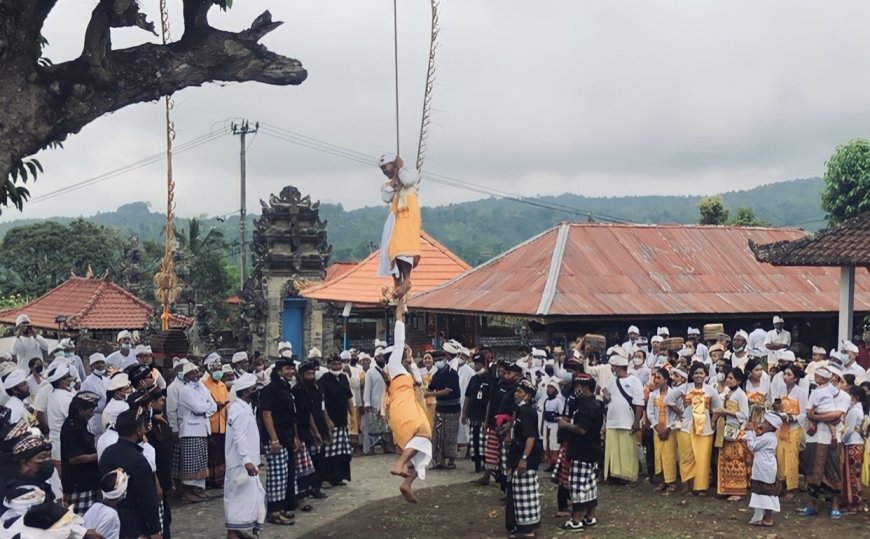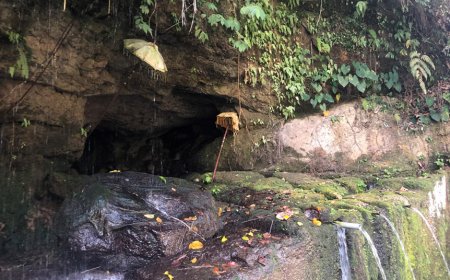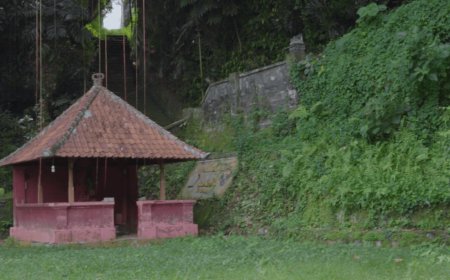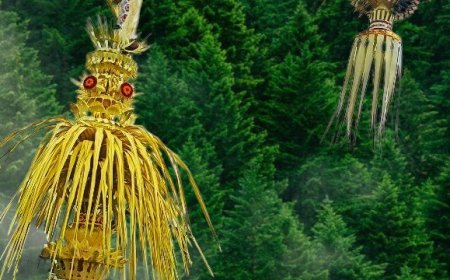Only Once a Year: The Sacred Rejang Ayunan, Swinging Dancing on the Cempaka Tree in Pupuan Village
Rejang Ayunan is a unique and sacred cultural offering in Pupuan Village, Tabanan, Bali. The dancers come from "Dehe Teruna", teenage boys who have just grown up. This dance with a unique procession, namely swinging on the Cempaka Tree, is only danced once every year. Behind its uniqueness, there are historical stories that have deep meaning for the people of Pupuan Village.
When exploring the charm of Bali Island, an island with a natural paradise and enchanting culture. We will be treated to a variety of local wisdom that adorns this island. One of them is the Rejang Ayunan. This may surprise you a little, in this dance the dancers "dance while hanging from a tree". Yes, you read that right. This dance procession is carried out by hanging from a tree alternately.
Rejang Ayunan, a unique and sacred offering performed with great majesty by the people who live at the foot of Batukaru Mountain, precisely in Pupuan Village, Pupuan District, Tabanan Regency. True to its name, the Rejang Ayunan dancers dance this dance by hanging from a rope that has been tied to a branch of the Cempaka Tree at Puseh Desa Bale Agung Pupuan Temple. Initially, the rope used came from a collection of "buun", tree branches tied together. However, due to its scarcity, its use has now shifted to gami rope. This dance can only be danced by "Dehe Teruna", teenage boy who has just "menek bajang" from Yowana Yodha Locita, Pupuan Village. This is a symbol of respect for the next generation who have entered adolescence.
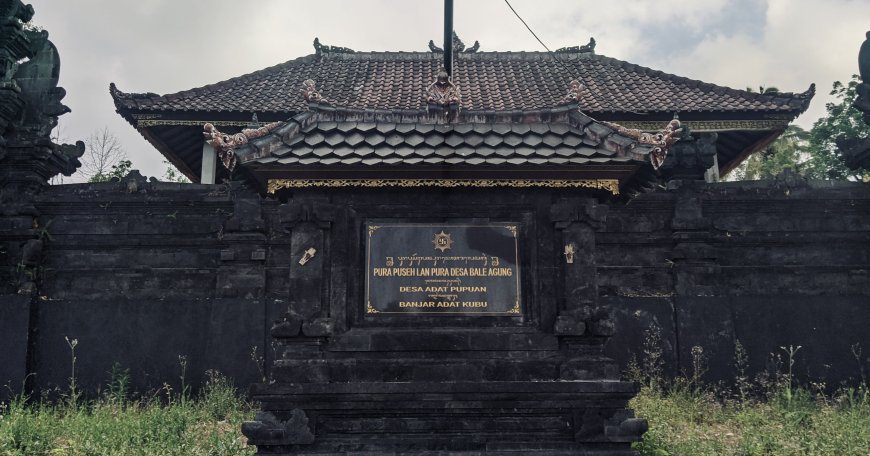
Puseh Desa Bale Agung Pupuan Temple (Photo Source: Editorial Collection)
However, who would have thought that behind the splendor of this dance there is a very interesting historical story and has deep meaning for the local community. The history of Rejang Ayunan is closely related to the history of Pupuan Village, the place where this tradition developed strongly. Initially, the Pupuan people lived in Sego, an area where they lived before Pupuan Village was founded. Unfortunately, Sego is located in the lowlands, which is often a source of problems due to ant attacks that damage farmers crops. The community finally decided to communicate with the "guardian of nature". The message received was that people were prohibited from building settlements in Sego.
The community then conducted a search to find a more suitable place to settle. Traveling by relying on trees that are used to "swing" from one location to another. Finally, the people found a place known as "Pelupuhan Kebo", an area where buffalo were usually bathed. The residents decided to establish a settlement there. Even though it sounds unusual, it was from this place that the name "Pupuan" emerged, which comes from the word "Pelupuhan" in this context referring to "Pelupuhan Kebo". Interesting right?
After settling in the new place, the residents began to develop agriculture and their land became fertile. This is where residents make a promise with the "guardians of nature", committing themselves to offering "ngayah" by presenting this sacred "Rejang Ayunan Dance" every celebrate Pujawali at Puseh Desa Bale Agung Pupuan Temple. This action is a form of gratitude to nature and the surrounding environment for the success of the farmers cultivation. In this tradition, people find harmony between humans and nature which is so valuable in accordance with the Tri Hita Karana concept.
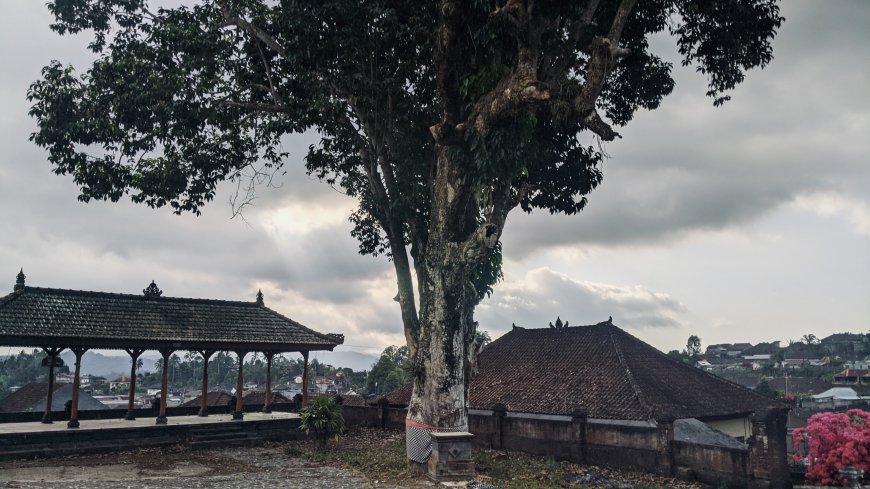
Cempaka Tree at Jaba Sisi Temple (Photo Source: Editorial Collection)
Rejang Ayunan was created, which can only be danced during Pujawali at the Puseh Desa Bale Agung Pupuan Temple, during the Kapat Full Moon which comes once a year. The Cempaka Tree from which the dancers swing is located at Jaba Sisi Temple, this is an important element of a very sacred ritual and has been going on for centuries. The Elders Puseh Desa Bale Agung Pupuan Temple, Jero Mangku I Wayan Subata, explained that this Cempaka Tree was discovered by residents to have grown tall since ancient times, even before he was born. This adds a touch of mystery to the cultural heritage that is so valuable to the people of Pupuan Village.
Rejang Ayunan involves several series that last for three days starting from Purnama Kapat. Starting with the Sacred Rejang "pang telu" at night during the Purnama Kapat. The next day continued with the Sacred Rejang "pang sia". After two days have passed from Purnama Kapat, the Rejang Ayunan will be danced. However, before this dance begins, there are initial preparations involving the Sacred Rejang "pang solas" where the "lanang" (male) and "istri" (female) dancers dance alternately, followed by pairs. Then, it will continue with the Tajong - Tajong Dance which is part of the Rejang Ayunan.
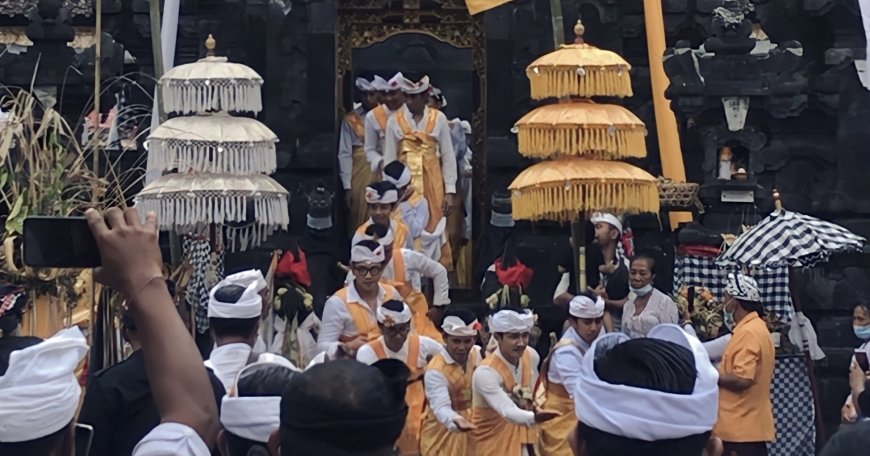
Tajong - Tajong Dance (Photo Source: Editorial Collection)
The Tajong - Tajong Dance is the initial dance performed before "Dehe Truna" swings on the Cempaka Tree. The movement in this dance is unique, namely raising one hand forward, then bringing it behind the back alternately while lifting the leg and doing it repeatedly. This movement has a deep meaning in the culture of the people, who constantly ask or "nunas paica" to Ida Bhatara Sesuhunan at Puseh Desa Bale Agung Temple. Apart from that, the movement of pulling the hand back illustrates the need to take or in Balinese terms "ngengkebang" the paica so that it is not taken by Bhuta Khala. Before performing the Tajong-Tajong Dance, the dancers will circle the "jeroan" (Jaba Utama) three times. After that, the dancers will move to Jaba Tengah and circle it three times, in a circular direction to the right. After this stage is finished, the dancers will go down to Jaba Sisi and take turns swinging on the Cempaka Tree, starting with Bendesa Adat or Village Elders, followed by "Dehe Teruna".
The number of dancers in Rejang Ayunan is not limited, as long as they meet the requirements of coming from “Dehe Teruna”. Around the 1980s, the only clothing worn by dancers was yellow cloth wrapped around their chests or what was usually called "metoros". On the back, the "maseselet" (tucked) with the “kadutan” (keris tied with a scarf). However, recently there has been a change in the clothing used, where now the dancers wear white safaris, before "metoros". These changes reflect developments and adaptations in the Rejang Ayunan tradition, but still maintain the essence and deep meaning of this dance.
At first, the clothes worn by the dancers were traditional temple clothes in general. However, recently there has been a change in the clothes used. Now the dancers wear white udeng and safari, plus a yellow cloth wrapped around their chests or what is usually called "metoros". On the back, a "kadutan" (keris) is inserted in the yellow cloth. These changes reflect developments and adaptations in the Rejang Ayunan tradition, but still maintain the essence and deep meaning of this dance.
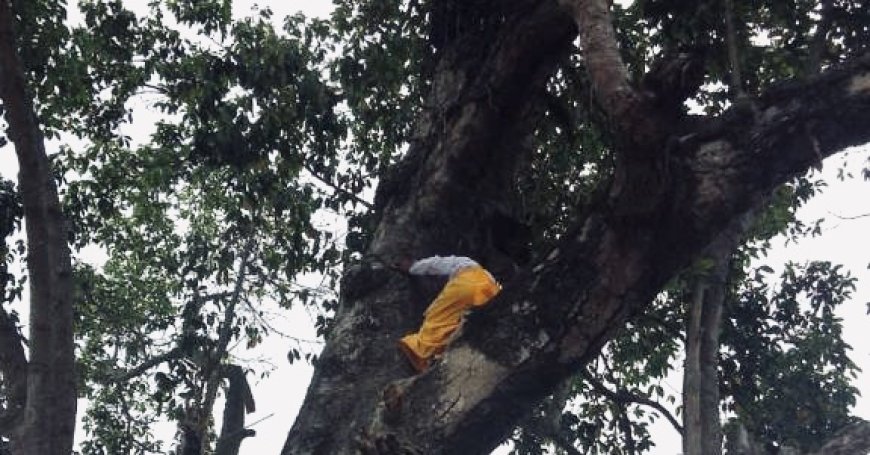
The Last Dancer Shares Rambut Sedana (Photo Source: Editorial Collection)
Apart from the Cempaka Tree, the Rejang Ayunan procession has another element that is no less important, namely the "kulkul" (kentongan) which is rung at the Bale Kulkul, Puseh Desa Bale Agung PupuanTemple. Similar to its function in ancient times, the kentongan here functions as a signal to gather residents. With the sound of kentongan, residents knew that this sacred dance was taking place and immediately gathered at Jaba Sisi Temple, precisely under the Cempaka Tree. The gathering of residents here is not without meaning, residents are waiting for the last dancer who will swing and be tasked with climbing the rope until they reach the tree branch. On the tree branch, a special "banten" has been prepared containing pejati, arak, chicken and 2000 money denominations.
The dancer then distributed "rambut sedana" (money) to residents waiting under the Cempaka Tree. Residents will fight to get a share of the "banten" distributed by the dancers as a form of "paica" requested by the community in accordance with the meaning of the previous Tajong-Tajong Dance, this procession is called "pedanan-danan". People believe that those who managed to get one of the banknotes from the "banten" have received "paica" from Ida, which is expected to bring blessings and good luck to their lives.
Rejang Ayunan is not only a dance, but also a window into a past that is still alive and gives meaning. As an inseparable part of the identity of Pupuan Village, this dance is a reminder of the importance of respecting nature as a manifestation of the Tri Hita Karana concept, namely "Palemahan". It is hoped that this story will continue to shine in the spotlight of Balinese culture, as a heritage that should be protected and preserved by future generations of "Dehe Teruna".

















































